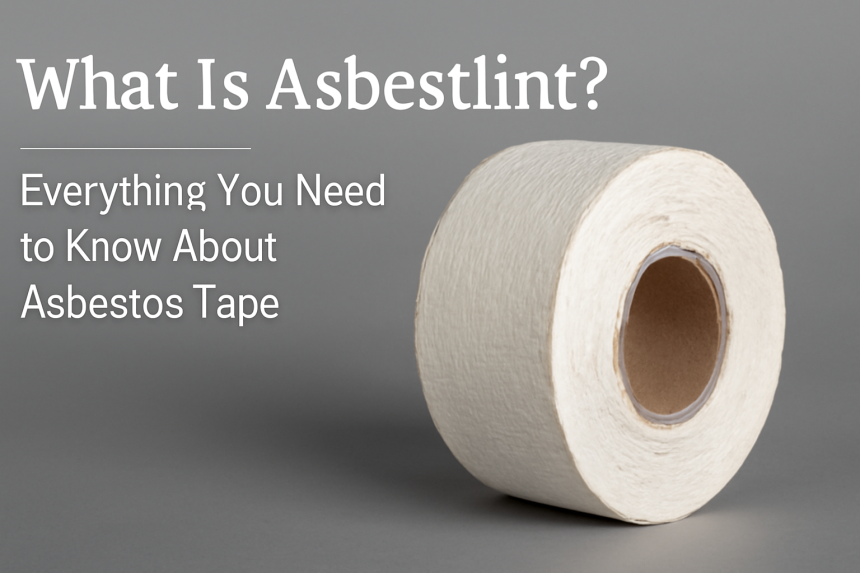Introduction
Asbestos is a naturally occurring mineral that has been widely used in various industrial and commercial applications for its heat-resistant properties. However, the harmful effects of asbestos exposure on human health have led to significant regulatory restrictions on its use in recent years. One such asbestos-containing product that played a vital role in many industries in the past is asbestlint, or asbestos tape. This article provides a comprehensive guide to understanding asbestlint, including its history, uses, health risks, identification methods, and safe handling practices.
What is Asbestlint? The Basics of Asbestos Tape
Asbestlint, also known as asbestos tape, is a flexible strip made of woven asbestos fibers. The tape is commonly used for insulating, sealing, and protecting surfaces exposed to high heat. These tapes are typically wrapped around pipes, ducts, and electrical systems to prevent heat loss, provide insulation, and prevent fires.
The main component of asbestlint is chrysotile asbestos, a type of asbestos fiber that was favored for its resistance to heat, fire, and electrical conductivity. This made asbestlint a popular choice for industrial, residential, and commercial applications, particularly in the mid-20th century.
While asbestlint proved to be highly effective for insulating and sealing, it also carries the potential to release dangerous asbestos fibers into the air if damaged or disturbed, posing a serious health hazard.
The Historical Use of Asbestlint in Industry and Construction
Asbestos became widely used in construction and industrial settings during the early 1900s, largely due to its superior fire-resistant and insulating properties. Asbestlint was primarily used in the following areas:
- Pipe Insulation: Asbestlint was commonly wrapped around steam, hot water, and refrigeration pipes to reduce energy loss and provide protection against high temperatures.
- Ductwork Sealing: Asbestos tape was used to seal joints in HVAC systems, preventing air leaks and improving energy efficiency.
- Electrical Insulation: The tape was also used in electrical applications to prevent short circuits, as it offered excellent electrical insulation.
- Automotive and Aerospace Industries: Asbestos tape was utilized in areas where high-temperature resistance was necessary, including in the automotive and aerospace industries.
The wide usage of asbestlint continued until the late 20th century when the health risks associated with asbestos exposure became more evident.
Health Risks of Asbestos Exposure from Asbestlint
Exposure to asbestos fibers, including those released by asbestlint, can lead to serious health conditions. Asbestos fibers are microscopic and, when inhaled, can lodge in the lungs and other parts of the body, causing damage over time. The key health risks associated with asbestos exposure include:
Asbestosis
Asbestosis is a chronic lung disease caused by the inhalation of asbestos fibers. It leads to scarring of lung tissue, resulting in shortness of breath, coughing, chest pain, and difficulty breathing. Asbestosis is progressive, meaning symptoms worsen over time.
Mesothelioma
Mesothelioma is a rare and aggressive cancer that affects the lining of the lungs, abdomen, or heart. It is primarily caused by asbestos exposure, and even brief exposure to asbestos fibers can increase the risk of developing mesothelioma. Unfortunately, the disease has a long latency period, often taking 20-50 years to develop after exposure.
Lung Cancer
Lung cancer is another severe risk associated with asbestos exposure, particularly when combined with smoking. The inhalation of asbestos fibers significantly increases the chances of developing lung cancer, and those who are exposed to asbestos in the workplace or through asbestlint are at higher risk.
Pleural Disease
Pleural disease involves thickening of the lining around the lungs (pleura), making it difficult to breathe. This can occur even without developing full-blown asbestosis or mesothelioma.
Identifying Asbestlint in Older Buildings
If you live in an older building, especially one constructed before the 1980s, there is a possibility that asbestlint was used in various areas for insulation and sealing purposes. Identifying asbestlint and other asbestos-containing materials is crucial to prevent exposure to harmful fibers. Here’s how you can identify asbestlint in your property:
- Appearance: Asbestlint typically appears as a white or gray, woven or fibrous tape. It may look somewhat similar to modern insulation tapes, but the key difference is its potential asbestos content.
- Location: Common areas to find asbestlint include around pipe insulation, ductwork, and electrical systems. It can also be present in industrial settings, particularly where heat resistance was required.
- Condition: Asbestos is most dangerous when it is disturbed or damaged. If asbestlint is intact and undisturbed, it may pose less immediate risk. However, if the tape is old, damaged, or deteriorating, the risk of fiber release is much higher.
Safe Handling and Removal of Asbestlint
When handling asbestlint, safety should be your top priority. Inhaling asbestos fibers, even in small amounts, can lead to severe health problems over time. If you suspect that asbestlint is present in your home or workplace, follow these guidelines for safe handling:
Avoid Disturbance
Do not touch or disturb any suspected asbestos-containing materials. Disturbing asbestlint can release harmful fibers into the air, increasing the risk of exposure. Even a small disruption, such as cutting or scraping the tape, can cause fibers to become airborne.
Hire a Professional Asbestos Inspector
The best course of action if you suspect the presence of asbestlint is to contact a licensed asbestos inspector. They can assess the situation, conduct air tests, and determine if asbestos is present. If asbestos is identified, they will recommend a course of action.
Professional Removal
Asbestos removal should only be done by trained and certified professionals. These experts will follow strict safety protocols to remove and dispose of the asbestos tape in a safe manner. They will also use specialized equipment, including respirators, protective clothing, and HEPA filters, to minimize the risk of fiber release during removal.
Encapsulation as an Alternative
In some cases, rather than removing asbestlint, encapsulation may be a safer and more cost-effective solution. Encapsulation involves sealing the material with a special coating to prevent fibers from being released into the air. This method is often used when the asbestlint is in good condition and removal would be unnecessarily disruptive.
Legal Regulations on Asbestos and Asbestlint
The use of asbestos in building materials, including asbestlint, is heavily regulated in many countries due to the health risks it poses. Regulations set forth by organizations like the Environmental Protection Agency (EPA) and Occupational Safety and Health Administration (OSHA) ensure that asbestos is handled safely and responsibly. Here’s an overview of some key legal considerations:
Occupational Safety and Health Administration (OSHA)
OSHA has established regulations that limit the amount of asbestos workers can be exposed to in occupational settings. These regulations also mandate that employers provide proper training, safety equipment, and medical monitoring to workers who may be exposed to asbestos.
Environmental Protection Agency (EPA)
The EPA provides guidelines for the safe removal, disposal, and management of asbestos in public and private buildings. It is illegal to discharge asbestos-containing waste into the environment, and strict procedures are in place to ensure safe handling during renovation or demolition projects.
Local and State Regulations
Many states and localities have additional regulations that govern asbestos removal. Always consult local laws and hire certified asbestos abatement contractors to ensure compliance with these regulations.
Alternatives to Asbestlint in Modern Insulation and Sealing
As the health risks of asbestos became more widely recognized, industries began developing safer alternatives to asbestlint. These alternatives offer the same high-performance properties—heat resistance and insulation—without the health risks associated with asbestos exposure. Some popular substitutes include:
- Fiberglass Tape: This tape is made from woven glass fibers and provides excellent heat resistance and insulation without the risks associated with asbestos.
- Silicone-Based Tape: Silicone tape is flexible, heat-resistant, and safe to use in high-temperature applications. It is often used in both residential and industrial settings as an alternative to asbestlint.
- Aluminum Foil Tape: Known for its durability and thermal resistance, aluminum foil tape is often used for sealing ducts and other high-temperature systems.
- Ceramic Fiber Tape: Made from ceramic fibers, this tape provides excellent heat resistance and is commonly used in industries requiring high-temperature sealing.
Steps to Take if You Find Asbestlint in Your Home
If you discover asbestlint in your home or building, it’s important to take the following steps to protect yourself and others from exposure:
- Do Not Disturb the Material: Avoid touching or disturbing the tape. If the tape is in good condition, it may be best to leave it alone until a professional can assess it.
- Contact a Certified Asbestos Inspector: Have a professional assess the material and determine if it poses a risk to your health.
- Follow Professional Recommendations: Depending on the findings, the inspector may recommend safe removal, encapsulation, or monitoring of the material.
Read More: Newspure.co.uk
Conclusion
While asbestlint was once an indispensable material for industrial insulation and sealing, the health risks associated with asbestos exposure have made it a dangerous substance to handle. Understanding the history, risks, and proper handling methods for asbestlint is critical for protecting both workers and residents from harmful exposure. Always consult with certified professionals when dealing with materials containing asbestos to ensure safety and compliance with legal regulations.





